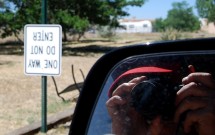
In August of 2011, I presented a 1 ½ hour talk on compassion fatigue in animal care work to about 35 people at the New Mexico State Humane Conference in Albuquerque. Soon after I returned to Ohio for my Internship, I got an e-mail from the sponsoring shelter in ABQ, asking when I could come down and do my presentation for about 60 of their employees. My first thought was, “Oh good grief…I’m in Ohio!!!” So I called back and said, “I’d love to, but I’m in Ohio, would you consider flying me back out…?” And they said “Sure!” I couldn’t believe it. As it turns out, this shelter brings someone in every year to do a presentation on this topic, and it’s mandatory for staff to attend. This is very progressive thinking. They usually contract a speaker from HSUS or American Humane, but they received such great feedback on my presentation in August, they decided to have me come this time! I felt very honored and blessed. At their request, I expanded the talk to 3 hours, and we decided to do two groups of 30 over a 2-day period.
As I went through the presentation on the first day, I noticed that the staff became more engaged as I went along, rather than sort of wilting after the second hour… They also seemed to be sort of… glowing. Afterwards, as I stayed on the campus for a couple of hours, they kept coming up and shaking my hand, saying “Thank You!!” “This was the best talk ever!” Management felt it, too, especially my main contact person, who attended the talk. Staff members scheduled for day two were saying “Gee, I can’t wait till tomorrow!” I had the same experience the next day, and when I got back to Ohio, my contact in ABQ E-mailed that she could still feel the reverberations on campus. So, here’s why I believe this worked…
First of all, the subject of compassion fatigue is not a popular one among those who are subject to it (police, fire, EMS, therapists, nurses, animal rescue workers.) We hear of it as a danger, as part of the “cost of caring” or, as I first saw it defined, “A disease of those who care.” Yuck. We’re often told that to combat it, we need to set boundaries, know when to say “no,” know how to “leave it at the office…” When I asked the staff how those methods worked for them, they said “Terrible!” Right. So my main message (SWC style) was to let compassion flow freely among us, and back onto ourselves. The feeling of relief in the room as I made this point was absolutely palpable. What a gift to be told they have a right to feel what they are feeling, let alone act on it! I then taught them lots of tools for getting through tough situations, and we practiced these together. They were so enthusiastic – we really had fun!
I also know that my experiences in that actual field created an immediate bond between us, and added credibility to the things I said. Here’s where disclosure really and truly worked toward the benefit of my audience. They not only knew I was one of them, but that I had struggled with the things they struggle with, and as one young lady put it, “You really walk you talk.” I can’t think of a better compliment, nor a better way to have reached them. My experiences in other areas (EMS, mental health, etc. ) added further credibility. I was very, very honest with them, too, and used personal examples to illustrate points. And, in the spirit of SWC, I stood up there at the front of the room as myself. Truly and authentically myself. And yes, we laughed a lot, and yes, I used physical gestures and expressions freely, as those of you who know me can perhaps imagine. As I said, we really had fun.
Lastly, here’s a story from the night before my first talk; I was going over my notes in my hotel room (a very nice hotel room, by the way!) making sure I wasn’t going to forget some important point, testing my timing to the halfway/break mark, and the 3-hour end of the lecture… I finally put it all away, and as I lay down, a voice in my head said, “The most important thing for you to do is love them.” A wave of relief swept over me, and I fell asleep with a smile on my face. Truly, this was what I carried onto the shelter campus the next day. And truly, everyone felt it.
The response from these precious, wonderful, passionate, dedicated people tells me that there is much work to be done in this area. All those in the helping professions subject to compassion fatigue, PTSD and STSD need a way to deal with this. And I believe we should teach them to deal with it in a way that validates their compassion, and that can keep compassion alive and thriving and healing every aspect of the planet every day.
I witnessed a transformation in that room by bringing this message (not “my” message) to them on those days, and it told me the message is true, and important, and sacred. So, I’d say to anyone out there who has experience in nursing, animal care, EMS, etc., to consider reaching out to this population to offer a message of love and hope. It may not be easy. There is, as I said, some resistance for folks to even say the words “compassion fatigue.” But if you can get in somewhere, it’s worth it. Carry on!
“And I ask Her is there medicine, and how to bind such wounds,
And the only word She whispers back is LOVE,
my Grandmother Moon.” – Drew Nelson
 Southwestern College Santa Fe, NM
Southwestern College Santa Fe, NM



